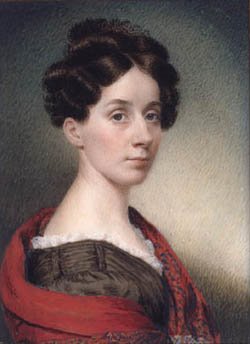Less well known is that the youngest brother of Napoleon, Jerome, a young officer of 25 in the French navy, was sent to Virginia to escape capture by the British in mid summer 1803. (Naploeon was at the height of his power, conquering nation after nation, but the British had rule of the seas). Visiting the city of Baltimore, Jerome fell head over heels in love with Miss Elizabeth (Betsy) Patterson, daughter of a vastly wealthy shipping merchant. The couple raised a stir of controversy when they were married less than six months later. What also arched eyebrows was Betsy’s penchant for dressing in the latest er/exotic Parisian fashions, as set by the artful Madame Bonaparte. Sheer, see-through materials, fabulously and revealingly low-cut in the “empire style”, caused a colossal scandal.
 As could be expected, Napleon had every intention that all siblings of his would make proper royal marriages, and the marriage of Jerome with an American girl was completely rejected. Unrelenting, Bonaparte did not even allow Jerome’s pregnant wife to disembark when the couple sailed to France in March of 1805.
As could be expected, Napleon had every intention that all siblings of his would make proper royal marriages, and the marriage of Jerome with an American girl was completely rejected. Unrelenting, Bonaparte did not even allow Jerome’s pregnant wife to disembark when the couple sailed to France in March of 1805.Whether his love for Betsy actually dwindled or whether temptations of unimaginable glory dangled before his eyes by his older brother held sway, Betsy was obliged to sail on to London without setting foot in Paris. Their son Jerome Napoleon Bonaparte was born there. The marriage was annulled by a French court in 1806.
From Lawrence Park:
Elizabeth Patterson, born in Baltimore, was the daughter of William Patterson and his wife Dorothy Spear. At a ball given at the home of Samuel Chase in the autumn of 1803 Jerome Bonaparte met and fell in love with her, but her father, foreseeing that the marriage would meet with the disapproval of Napoleon Bonaparte, at that time First Consul, sent his daughter to Virginia. Correspondence was carried on between the pair, however, and finally, on December 24, 1803, all the legal formalities carefully complied with, Jerome and Elizabeth were married in state by Archbishop Carroll at Baltimore; but Napoleon remained obdurate and Jerome Bonaparte was sent for. The youthful pair sailed in March 1805, only to find that Elizabeth was not allowed to land. She finally sought refuge in England, where her son, Jerome Napoleon Bonaparte, was born July 7, 1805. Jerome Bonaparte, the husband, was finally prevailed upon to divorce his wife. Elizabeth Patterson Bonaparte tried every means to maintain the legality of her marriage, and when Napoleon III came to the throne a formal trial was granted her, and the councils decreed that her son was entitled to the name of Bonaparte, but could not be considered a member of the Imperial family. Elizabeth Patterson Bonaparte was a woman of great beauty and force of character, retaining to the last her brilliant conversational powers.
Washington 1804. Canvas, 28 x 24 inches. In this very beautiful picture, Stuart painted the head and shoulders of Madame Jerome Bonaparte in three different positions. In the center she is shown full-face, with her soft hazel eyes directed to the spectator. Her auburn hair is dressed in a simple manner with curls on her forehead and in front of her ears. Over her right shoulder a seond head is seen peeping, bent slightly towards the left, with eyes turned to the spectator. At the right of the canvas a third head is seen in profile, the left side of the face with its charming contour turned to the spectator. The flesh tints of this painting are exquisite and the colors of the scumbled background range from a rich dark brown at the outer edge to a lighter shade towards the center where tints of lavender may be seen as it turns into a soft gray.






 Grace Fletcher, by Chester Harding (1792-1866)
Grace Fletcher, by Chester Harding (1792-1866)





















